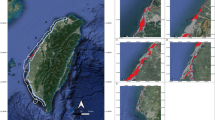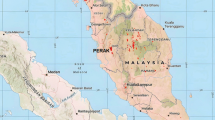Abstract
An analysis of the floating islands of Kuttanad–Vembanad Wetland Ecosystem (KVWE) was conducted as part of a major study on aquatic macrophyte vegetation of Kuttanad from November 2004 to November 2006. The study revealed that there are three types of floating islands in KVWE which vary considerably in their origin, development, species composition, community and physical structure and sustenance even though there are common vegetation elements. Among the three types the type-1 which formed in deep excavated portions of abandoned rice fields is found as the biotic climax in the ecological succession. Continuous abandoning of rice fields, stagnation, nutrient enrichment, proliferation of exotic invasive plants and less salinity and tidal flow are the major ecological factors which are found promoting this recent formation of floating islands here indicating the level of deterioration of the ecosystem. KVWE is one of the fast changing wetland sites of the world located in the State of Kerala, India with well developed and ancient culture, economy, art and rich biodiversity. Rice cultivation need to be promoted at all costs in order to save this wetland.






Similar content being viewed by others
References
Adam N (1979) The floating islands of Rawa Pening and their socio-economic aspects. BIOTROP Bull (Bogor Indonesia) 11:209–217
Adams CS, Boar RR, Hubble DS, Gikunju M, Harper DM, Hickley P, Tara-Wahlberg N (2002) The dynamics and ecology of exotic tropical species in floating plant mats: lake Naivasha, Kenya. Hydrobiologia 488(1–3):115–122. doi:10.1023/A:1023322430005
Azza N, Denny P, Koppel JVD, Kanshme F (2006) Floating mats: their occurrence and influence on shoreline distribution of emergent vegetation. Freshw Biol 51(7):1286–1297. doi:10.1111/j.1365-2427.2006.01565.x
Boughey AS (1963) The explosive development of floating weed vegetation on Lake Kariba. Amazoniana 3:49–61
Cherrya JA, Goughb L (2006) Temporary floating island formation maintains wetland plant species richness: the role of the seed bank. Aquat Bot 85(1):29–36. doi:10.1016/j.aquabot.2006.01.010
Clark MW (2000) Biophysical characterization of floating wetlands (Flotant) and vegetative succession of a warm-temperate aquatic ecosystem. Dissertation, University of Florida
Cook CDK (1996) Aquatic and wetland plants of India. Oxford, London
Denny P (1984) Permanent swamp vegetation of the Upper Nile. Hydrobiologia 110(1):79–90. doi:10.1007/BF00025778
Gamble JS, Fisher CEC (1915–1936) Flora of the presidency of Madras, vol I–III. Allard & Sons Ltd, London
Gippel CJ (1993) Hydrological management of a lake with floating islands near Pirron Yallok, Victoria, Australia. J Environ Manage 37(3):219–238. doi:10.1006/jema.1993.1018
Gopal B, Zutshi DP, Van Duzer C (2003) Floating islands in India: control or conserve? Int J Ecol Environ Sci 29:157–169
Haraguchi A (1991) Effect of flooding-drawdown cycle on vegetation in a system of floating peat mat and pond. J Ecol Res 6(3):247–263. doi:10.1007/BF02347126
Haraguchi A, Matsui K (1990) Nutrient dynamics in a floating mat and pond system with special reference to its vegetation. J Ecol Res 5(1):63–79. doi:10.1007/BF02348464
Harper DM, Muchiri M, Mavuti K (1990) Ecology and management of Lake Naivasha, Kenya in relation to climatic change, alien species introductions and agricultural development. Environ Conserv 17:328–335
Harper DM, Adams C, Mavuti K (1995) The aquatic plants of Lake Naivasha wetland, Kenya: pattern, dynamics and conservation. Wetlands Ecol Manage 3(2):111–123
Hill R, Webb G (1982) Floating grass mats of the Northern Territory–an endangered habitat? Wetlands 2:45–50
Hill R, Webb GJW, Smith MA (1987) Floating vegetation mats on a flood plain billabong in the northern territory of Australia. Hydrobiologia 150(2):153–164. doi:10.1007/BF00006663
Hogg EH, Wein RW (1988a) The contribution of Typha components to floating mat buoyancy. Ecology 69(4):1025–1031. doi:10.2307/1941258
Hogg EH, Wein RW (1988b) Seasonal change in gas content and buoyancy of floating Typha mats. J Ecol 76(4):1055–1068. doi:10.2307/2260633
Hooker JD (1872–1894) Flora of British India, vol I–VII. Reeve & Co, London
Huffman RT, Lonard RI (1983) Successional pattern on floating vegetation mats in a south western Arkansas bald cypress swamp. Castanea 48:73–78
Junk W (1970) Investigations on the ecology and production biology of the ‘floating meadows’ (Paspalo-Echinochloetum) on the Middle Amazon, Part I—the floating vegetation and its ecology. Amazoniana 2:449–495
Junk W (1973) Investigations on the ecology and production biology of the ‘floating meadows’ (Paspalo-Echinochloetum) on the Middle Amazon, Part II—the aquatic fauna in the root zone of floating vegetation. Amazoniana 4:9–102
Junk W (1977) The invertebrate fauna of the floating vegetation of Bung Borapet, a reservoir in central Thailand. Hydrobiologia 53(3):229–238. doi:10.1007/BF00818545
Kashyap SR (1920) Note on the floating islands of Riwalsar. J Indian Bot Soc 1:252–253
Kaul V, Zutshi DP (1966) Some ecological considerations of floating islands in Srinagar Lakes. Proc Natl Acad Sci USA 36B:273–281
Keddy PA (2000) Wetland ecology: principles and conservation. Cambridge University Press, Cambridge
Lind EM (1956) Studies in Uganda swamps. Uganda J 20:166–176
Little ECS (1969) The floating islands of Rawa Pening. Proc Natl Acad Sci USA 15:146–153
Mallison CT, Stocker RK, Cichra CE (2001) Physical and vegetative characteristics of floating islands. J Aquat Plant Manage 39:107–111
Manickam VS, Irudayaraj V (1991) Pteridophyte flora of Western Ghats, south India. BI Publishers, New Delhi
Mitsch WJ, Gosselink JG (2000) Wetlands, 3rd edn. John Wiley, New York
Oliver MK, McKaye KR (1982) Floating islands: a means of fish dispersal in Lake Malawi, Africa. Copeia 1982(4):748–754. doi:10.2307/1444082
Padmakumar KG, Krishnan A, Manu PS, Shiny CK, Radhika R (2002) Thanneermukkom barrage and fishery decline in Vembanad wetlands. Proceedings of 12th Kerala Science Congress, Kerala State Council for Science Technology and Environment, Thiruvananthapuram
Pallis M (1915) The structural history of Plav: the floating fen of the delta of Danube. J Linn Soc (Bot) 43:233–290
Power P (1996) Direct and indirect effects of floating vegetation mats on Texas wild rice (Zizania texana). Southwest Nat 41(4):462–464
Rai DN, Munshi JD (1979) The influence of thick floating vegetation (Water Hyacinth: Eichhornia crassipes) on the physico-chemical environment of a fresh water wetland. Hydrobiologia 62(1):65–69
Reid GK (1952) Some considerations and problems in the ecology of floating islands. Q J Fla Acad Sci 15:63–66
Russel RJ (1942) Floatant. Geogr Rev 32(1):74–98. doi:10.2307/210360
Rzoska J (ed) (1976) The Nile: biology of an ancient river. Junk, The Hague
Sahni B (1927) A note on the floating islands and vegetation of Khajiar near Chamba in the N.W. Himalayas. J Indian Bot Soc 6:1–7
Sasser CE, Visser JM, Evers DE, Gosselink JG (1995) The role of environmental variables on inter-annual variation of species composition and biomass in a subtropical minerotrophic floating marsh. Can J Bot 73(3):413–424. doi:10.1139/b95-042
Sasser CE, Gosselink JG, Swenson EM, Swarzenski CM, Leibowitz NC (1996) Vegetation, substrate and hydrology in floating marshes in the Mississipi river delta plain wetlands, USA. Vegetatio 122(2):129–142. doi:10.1007/BF00044695
Sculthorpe CD (1967) The biology of aquatic vascular plants. Edward Arnold Publishers, London
Scutcliffe JV (1974) A hydrological study of the southern sudd region of the upper Nile. Hydrol Sci Bull 19:237–255
Sharma C (1970) Origin of floating islands in the lakes at Khajiar and Rawalsar in Himachal Pradesh. The Paleobot 19(3):270–276
Singh SS (2002) Vegetation and Phumdi of Keibul Lamjao National Park. In Trisal CL and Manihar Th (eds) Proceedings of the Workshop on Management of Phumdis in Loktak Lake held at Imphal, Manipur, 22–24 January, 2002. Wetlands International South Asia and Loktak Development Authority, New Delhi
Somodi I, Botta-Dukat Z (2004) Determinants of floating island vegetation and succession in a recently flooded shallow lake, Kis-Balaton (Hungary). Aquat Bot 79(4):357–366. doi:10.1016/j.aquabot.2004.03.002
Thompson K (1985) Emergent plants of permanent and seasonally-flooded wetlands. In: Denny P (ed) The Ecology and Management of African Wetland Vegetation. Dr. W. Junk Publishers, Dordrecht, pp 43–108
Tiner RW (1999) Wetland indicators: a guide to wetland identification, delineation, classification and mapping. Lewis publishers, Boca Raton
Trivedy RK, Sharma KP, Goel PK, Gopal B (1978) Some ecological observations of floating islands. Hydrobiologia 60(2):187–190. doi:10.1007/BF00163185
Van Duzer C (2001) Preliminary note on the floating islands of Zacaton Sinkhole, Mexico. Aquaphyte 21(2):4–5
Van Duzer C (2006) Addenda to floating islands: a global bibliography, with an edition and translation of GC Munz’s Exercitatio academica de insulis natantibus (1711). Cantor Press, Los Altos Hills
Varfolomeyeva TA (1977) The floating vegetation mats of the Izheusk Reservoir. Hydrobiologia 13:47–50
Walker BH, Rogers KH, Ellery WN, Ellery K (1990) Formation, colonisation and fate of floating sudds in the Maunachira river system of the Okavango Delta, Botswana. Aquat Bot 38(4):315–329. doi:10.1016/0304-3770(90)90027-I
Acknowledgments
The authors are indebted to Late Dr. R. Satheesh, former Reader and Dr. A. P. Thomas, Professor and Director of School of Environmental Sciences for their encouragements and suggestions. We are also thankful to Dr. A. K. Pradeep, Dept. of Botany, Calicut University and Dr. R. Ansari and Mr. P. A. Krishnan of Malabar Botanical Garden for their help in the identification of plants. The grant (J-22012/23/2003-W dt. 16. 10. 2003) from the Ministry of Environment and Forests, Govt. of India provided financial support for this study.
Author information
Authors and Affiliations
Corresponding author
Rights and permissions
About this article
Cite this article
John, C.M., Sylas, V.P., Paul, J. et al. Floating islands in a tropical wetland of peninsular India. Wetlands Ecol Manage 17, 641–653 (2009). https://doi.org/10.1007/s11273-009-9140-z
Received:
Accepted:
Published:
Issue Date:
DOI: https://doi.org/10.1007/s11273-009-9140-z




